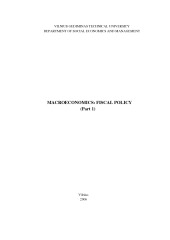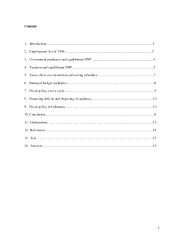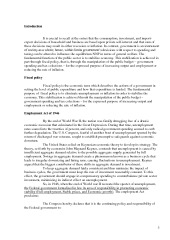Macroeconomics: Fiscal Policy



Macroeconomics: Fiscal Policy.
Taxes like saving and imports, are leakage from the domestic income expenditures stream. Saving, importing and paying taxes are all uses of income which do not involve domestic consumption. Consumpton will now fall short of national output – thereby creating a potencial spending gap – in the amount of after-tax saving and imports plus taxes. This gap may be filled by planned investment, exports, and government purchases. Hence, our equilibrium is: After-tax saving, Sa, plus imports plus taxes equals planned investment plus exports plus government
purchases (Sa + M + T = In + X + G)
If government purchases of goods and services (G) and tax revenues (T) are both not equal to zero, the equilibrium NNP is After-tax saving, Sa, plus imports plus taxes equals planned investment plus exports plus government purchases (Sa + M + T = In + X + G). Taxes cause DI to fall short of NNP by the amount of the taxes. This decline in DI in turn causes both consumption and saving to be less at each level of NNP. The sizes of the declines in C and S are determined by the MPC and MPS. And because saving, importing and paying taxes are all uses of income which do not involve domestic consumption. Consumpton will now fall short of national output – thereby creating a potencial spending gap – in the amount of after-tax saving and imports plus taxes. This gap may be filled by planned investment, exports, and government purchases. What is more, increases in taxes will lower the aggregate expenditures schedule relative to the 45-degree line and cause the equilibrium to fall.
With an MPS of one-fourth, the imposition of taxes of $20 billion will reduce disposable income by $20 billion and saving by $5 billion at each level of NNP. This is shown by the shift from S (saving before taxes) + M to Sa (saving after taxes) + M.
The $20 billion of taxes constitutes an additional $20 billion leakage at each NNP level, giving us Sa + M + T. By adding government, the equilibrium condition changes from S + M = In + X to Sa + M + T = In + X + g.
Government spending has a direct and unadulterated impact upon aggregate expenditures. Government spending is a component of aggregate expenditures and, when government purchases increase by the certain amount, the aggregate expenditures schedule shifts upwards by the entire certain amount.
But a change in taxes affecs aggregate expenditures indirectly by changing disposable income and thereby changing consumption. Specifically, our lump-sum tax increase shifts the aggregate expenditures schedule downwards only by the amount of the tax times the MPC. For example, if we have tax of $20 billion, it will increase shifts the aggregate expenditures schedule downward by $15 billion (=$20 billion × ¾). The overall result is a net upwards shift of the aggregate expenditures schedule of $5 billion which, subject to a multiplier of 4, boosts NNP by $20 billion. This $20 billion increase in NNP is equal to the size of the initial increase in government expenditures and taxes. That is, the balanced budget multiplier is 1.
- Economy & Finance Papers
- Microsoft Word 34 KB
- 2017 m.
- English
- 16 pages (5275 words)
- University
- Ugnelakys
















